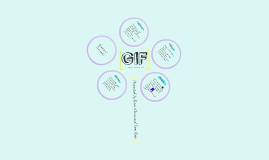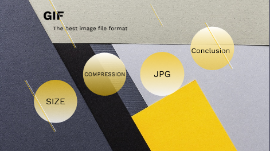GIF
Transcript: SVG (Scalable Vector Graphics) Vector graphics for the web. This Adobe-sponsored standard for placing true Vector graphics online has failed to catch-on in any significant way. Although approved by the W3C (the body which governs Internet standards) there is poor browser support and very little interest in this file type. Lossless compression. JPEG (Joint Photographic Experts Group) Developed by the Joint Photographic Experts Group, JPEGS are perhaps the most well-known of the graphics family, being used in many areas of digital life, including websites, digital cameras, mobile phones, and a variety of other media. JPEGS allow full colour photographic quality images to be saved in relatively good detail with lossy compression applied. The greater the level of compression, the more quality is lost from the image. It is possible to create a very large high quality JPEG with no compression to achieve outstanding quality in printed reproduction, as well as very small compressed files for websites, which makes JPEGS a very versatile option for a plethora of uses. http://visualise.com/panoramas Graphic File Formats http://www.logodesignworks.com/blog/vector-graphics-and-raster-graphics-difference PSD (PhotoShop Document) Native format of popular Bitmap art creation software. Adobe Photoshop is one of the most widely-used products in the industry, renowned for its wealth of creative tools and useful options for designers and digital graphic artists. Any graphics file saved in the PSD format can maintain the layers and effects that were generated in Photoshop thus making it fully editable in the software. TIFF (Tagged Image File Format) Prepress file format for raster data such as photos. TIFF remains a popular format in press and sign studios. It is strictly a Bitmap-only format, which cannot support any type of Vector data, and can have levels of compression applied. TIFF supports a very wide range of colour models and resolutions and is known for its versatility and reliability, although it does produce very large files when used with high quality images. Lossy compression. GIF (Graphic Image File) Indexed color file, mostly for the web. The current version supports 1-bit transparency and simple animation. GIF is the best web option for images with flat, solid colors - the sort of images you normally create in Vector drawing programs like Illustrator. GIF is rarely a good choice for non-Web use and one of the worst for high quality print. GIF is a "lossless" format meaning that even after the file has been compressed no quality is lost from the image quality. PNG (Portable Network Graphics) Designed to replace the GIF on the web, but hasn't. Recent substitute for GIFs (and some JPEGs) online. Many technical advantages over GIFs - for example, multi-bit transparency map, metadata for color management (gamma and profile) - but also larger file sizes. There is very uneven browser support so far, so it hasn't really caught on. Lossy compression. AI (Adobe Illustrator) Native format of popular Vector art creation software. Adobe Illustrator format is widely-used by many graphic studios because it is easy to work with and can be saved as PDF or EPS with minimal fuss for portability. As well as designing Vector-based graphics, AI can embed Bitmap images. Lossless compression. Vector Image SWF (Small Web Format) Popular online Flash media file. Macromedia Flash is widely used online to produce Vector-based graphics and animation. It has no real use outside of web design. Lossless compression. CDR (CorelDraw) Native format of popular Vector art creation software. CorelDraw is similar to Adobe Illustrator in that it is primarily a Vector graphics creation product which can output files in many different useful formats and can embed Bitmaps. Lossless compression Raster image BMP (Bitmap) Microsoft's own home-grown image format. Microsoft's own Bitmap BMP file type is used in the Windows environment for various purposes, such as displaying icons, but has very little purpose outside of that remit. BMP files are unsuitable for web use or for print. Lossy compression.

















